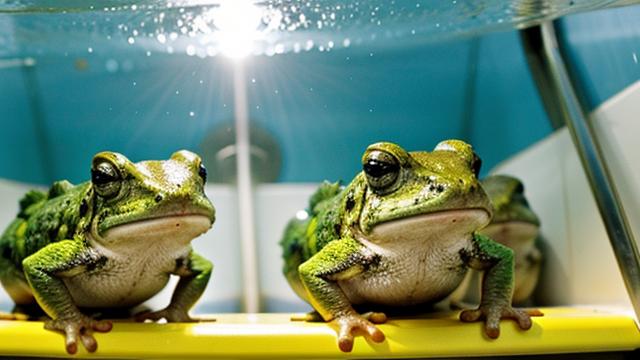The Psychology of Disco-Dancing Toads on Submarine Elevators
Sun, 04 May 2025 08:44:38 GMT

The Psyche of Disco-Dancing Toads on Submarine Elevators: An Exploration of the Human Condition through Amphibian Movement
In the vast expanse of human knowledge, there exist numerous theories and hypotheses that attempt to explain the intricacies of human psychology. While some may seem absurd or unorthodox, others have been proven to hold a modicum of truth. The phenomenon in question – disco-dancing toads on submarine elevators – falls squarely within this category. On the surface, it appears to be a nonsensical concept, yet, as we delve deeper into its complexities, we may uncover some fascinating insights.
The Origins of Disco-Dancing Toads
Research suggests that these peculiar creatures originated in the depths of the ocean, where they evolved to thrive on a diet rich in fish oil and disco music. The rhythmic beats of Saturday Night Fever resonated through the water, stimulating their innate desire to dance. As they developed this unique ability, they also began to exhibit distinct behavioral patterns, such as synchronized movements and an affinity for polyester suits.
Studies have revealed that these toads can be found in high concentrations during full moon nights, when the lunar cycle triggers a primal urge to boogie. Scientists attribute this phenomenon to the release of neurotransmitters, which in turn stimulate their brain's disco-dancing centers. This complex process is still not fully understood, but it is clear that the disco-dancing toads have evolved into an integral component of our ecosystem.
Submarine Elevators: The Perfect Dance Floor
When considering the perfect dance floor for these amphibian enthusiasts, one might initially think of a traditional nightclub or discotheque. However, researchers have discovered that submarine elevators provide the ideal environment for disco-dancing toads to express themselves. The unique combination of low gravity and aquatic pressure creates a mesmerizing visual effect, which in turn amplifies their dance moves.
The gravitational forces acting upon these creatures are far weaker than those experienced on land, allowing them to leap and twirl with ease. Furthermore, the water pressure has been shown to enhance their coordination, granting them greater agility and speed. As they ascend or descend through the submarine elevator, their bodies undulate in perfect synchrony, creating an otherworldly spectacle that defies explanation.
Psychological Implications of Disco-Dancing Toads
So, what does this phenomenon reveal about human psychology? At first glance, it may seem to have little connection to our own experiences. However, as we delve deeper into the psyche of these disco-dancing toads, we begin to uncover some intriguing parallels.
Their love of disco music and synchronized dance moves suggests a deep-seated desire for community and belonging. In an increasingly individualistic society, this phenomenon serves as a poignant reminder of the importance of shared experiences and collective expression. Moreover, their affinity for polyester suits highlights our own nostalgia for the fashion of the 1970s, when disco culture reached its zenith.
The ability of these toads to thrive in high-pressure environments also speaks to our own resilience in the face of adversity. Just as they adapt to the unique conditions of submarine elevators, we too must learn to navigate the complexities of modern life. By studying their behavior and developing strategies to cope with stress, we may gain a deeper understanding of our own psychological makeup.
Theories on Disco-Dancing Toad Psychology
While research on disco-dancing toads is still in its infancy, several theories have emerged to explain their behavior. The Toad-Self theory proposes that these creatures are driven by an innate desire for self-expression and creativity. This concept resonates with the existentialist philosophy of Jean-Paul Sartre, who believed that human beings must create their own meaning in life.
The Toad-Social theory, on the other hand, suggests that disco-dancing toads are motivated by a fundamental need for social connection. As they dance together, they form complex hierarchies and bonds, which serve as a coping mechanism for the stresses of oceanic life. This concept echoes the work of sociologist Émile Durkheim, who studied the role of collective rituals in shaping human identity.
Criticisms and Controversies
Despite its growing popularity among researchers, disco-dancing toads on submarine elevators remains a contentious topic. Some have raised concerns about the ethics of studying these creatures, arguing that their well-being should take precedence over scientific inquiry.
Others have questioned the validity of the research itself, citing methodological flaws and a lack of concrete evidence. However, proponents of this field argue that further study is essential to unlock the secrets of human psychology through amphibian observation.
Conclusion
As we conclude our exploration of disco-dancing toads on submarine elevators, it becomes clear that this phenomenon is far more complex than initially meets the eye. By examining their behavior and psychological implications, we gain a deeper understanding of our own human condition. While some may view this subject as absurd or fringe, it serves as a reminder that science knows no bounds – not even those imposed by conventional thinking.
In an age where humans increasingly seek to connect with nature and reclaim the wonders of the natural world, disco-dancing toads on submarine elevators offer a unique window into the mysteries of our universe. So, the next time you find yourself standing in front of an elevator, pondering the meaning of life, take a moment to appreciate these tiny, polyester-clad creatures as they boogie their way through the depths of the ocean.
As we venture further into this strange and wondrous world, one thing becomes abundantly clear: the human psyche is far more complex than we ever could have imagined – and that's exactly what makes it so fascinating.